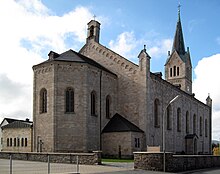Deanery Medebach
The dean's office Medebach was a dean's office in the Archdiocese of Cologne . The oldest written evidence of this goes back to the 14th century. In 1821 it was transferred to the Diocese of Paderborn together with other parts of the Archdiocese of Cologne in southern Westphalia . After various reorganizations in the 19th and 20th centuries and the associated spatial changes, it was merged into the Bigge-Medebach Dean's Office in 1977.
history
The oldest evidence for the existence of the dean's office in Medebach is an entry made in the so-called "Liber Valoris" at the beginning of the 14th century. This is one of the oldest lists of the parishes of the Archdiocese of Cologne. Eight parishes are listed in the Medebach deanery, namely Deifeld , Düdinghausen , Eppe , Grönebach , Medebach , Merklinghausen (which later became part of the newly established Hallenberg parish ), Münden (which was later separated from the deanery) and Züschen . As a result of the establishment of the city of Winterberg , another parish was added. Neukirchen was formed as a parish in the 14th century. This also applies to Hesborn , which existed for the first time as an independent parish between 1332 and 1463, but was later united with Züschen until the 18th century.
In the Middle Ages and the early modern period, the dean's office in Medebach belonged to the archdeaconate of the Cologne cathedral propst . During the Reformation period , a church reformation took place in some parishes. After the success of the Counter Reformation in the so-called Cologne War , this was gradually pushed back. The Glindfeld Monastery , located in the deanery, proved to be an important and successful actor. In recognition of this, the Archbishop of Cologne, Maximilian Heinrich von Bayern, determined in 1682 that in future the prior of Glindfeld Monastery should automatically be dean of Medebach. This regulation was maintained until the abolition of the monastery in 1804.
In 1802 the deanery consisted of the eleven parishes Altastenberg (separated from Winterberg in 1785), Deifeld, Düdinghausen, Eppe, Grönebach, Hallenberg, Hesborn, Medebach, Silbach (which originally belonged to Grönebach), Winterberg and Züschen. In 1821 it was transferred to the diocese of Paderborn together with the other Westphalian parts of the Archdiocese of Cologne as part of a rewrite of the Catholic dioceses in Germany after the Congress of Vienna by the bull De salute animarum by Pope Pius VII . In 1832 the deanery was expanded to include the parishes of Assinghausen and Brunskappel . In 1848 the parish of Neuastenberg was created by the parish of Altastenberg and in 1893 the parish of Niedersfeld by parish of Grönebach. Korbach , which became Protestant during the Reformation, was given a Catholic parish in 1912 through the parish of Eppe.
In 1913 there were 17,847 Catholics and 15,767 people of different faiths in the Medebach deanery.
structure
The Deanery Medebach spatially corresponded roughly to the older office Medebach . In the north it bordered on the deanery Meschede , to which the deanery Brilon was added later . In the east and south it formed the border of the Archdiocese of Cologne. In the west it bordered on the Wormbach deanery . Through various affiliations and separations of various neighboring parishes in the 19th and 20th centuries, its boundaries changed several times until it merged with the Bigge dean's office in 1977, when it merged into the newly founded Bigge-Medebach dean's office .
Today the parishes of the historical dean's office in Medebach form several pastoral rooms that belong to the dean's offices of Hochsauerland-Ost and Waldeck of the Archdiocese of Paderborn.
List of deans
- 1629–1653 Everhard Brunhardt
- 1653–1667 Petrus Henning
- 1667–1668 Johann Bonaventura Volmershausen
- 1668–1676 Johann Conradi
- 1677–1682 Petrus Henning
- 1682–1689 Winandus Vest
- 1689-1710 Petrus Cramer
- 1710–1719 Johann Leifert
- 1719–1762 Heinrich Coal
- 1762–1796 Rudolf Lefarth
- 1796–1804 Heinrich Gerwin
- 1820–1852 Moritz Anton Leisten
- 1895 Friedrich Anton Grimme
- 1909 Ferdinand Schlinkert
literature
- Hans Jürgen Brandt / Karl Hengst: History of the Archdiocese of Paderborn. Third volume: The Diocese of Paderborn in the Industrial Age 1821–1930, Paderborn 1997, pp. 30–52.
- Hans Jürgen Brandt / Karl Hengst: History of the Archdiocese of Paderborn. History - People - Documents, Paderborn 1989, p. 58f.
- Albert K. Hömberg: Church and secular state organization (parish system and court system in the original parish areas of the southern Sauerland), Münster 1965, pp. 2–7.
- Harm Klueting: The Duchy of Westphalia as a spiritual territory in the 16th to 18th centuries, in: The Duchy of Westphalia. Volume 1: The Electoral Cologne Duchy of Westphalia from the beginnings of Cologne rule in southern Westphalia to secularization in 1803, Münster 2009, pp. 443-518.
- Hansgeorg Molitor: The Archdiocese of Cologne in the Age of Faith Struggles 1515–1688, Cologne 2008, p. 295, 403–414.
- Reinhard Müller: The visitation of the Duchy of Westphalia by the Cologne Vicar General Johann Arnold de Reux (1716/17), Paderborn 2018, ISBN 978-3-95645-462-2 , pp. 53-59.
- Schematism of the Diocese of Paderborn, Paderborn 1895, pp. 86–90.
- Schematism of the Diocese of Paderborn, Paderborn 1909, pp. 132-137.
- Real-Schematism of the Diocese of Paderborn, Paderborn 1913, p. 97 *, 246-258.
- Hans Ulrich Weiß: Glindfeld - Lords of the Cross. In: Karl Hengst (Hrsg.): Westfälisches Klosterbuch. Lexicon of the monasteries and monasteries established before 1815 from their foundation to their abolition. Part 1: Ahlen - Mülheim. Aschendorff, Münster 1992, ISBN 3-402-06886-9 , pp. 359-362 ( Sources and research on the history of church and religion 2, publications of the Historical Commission for Westphalia 44).
